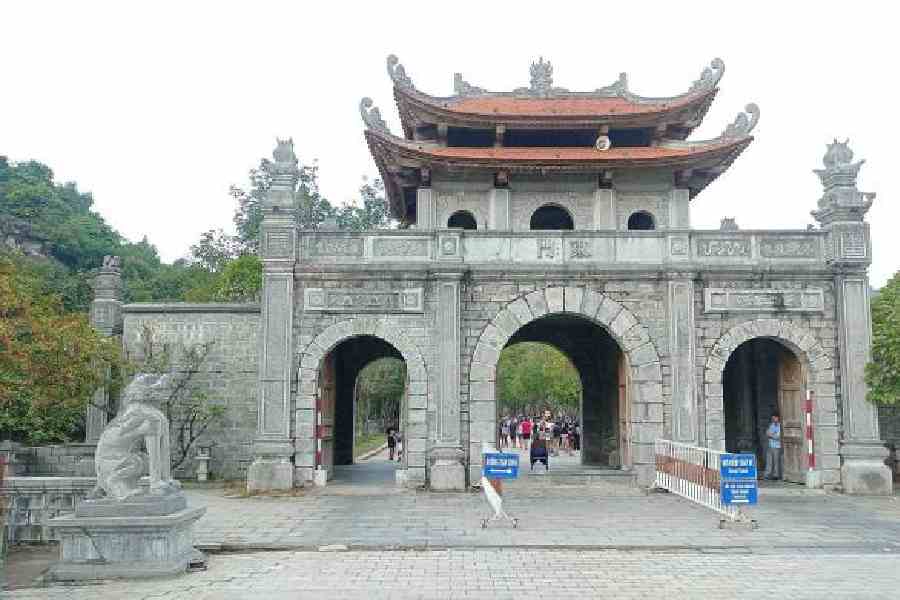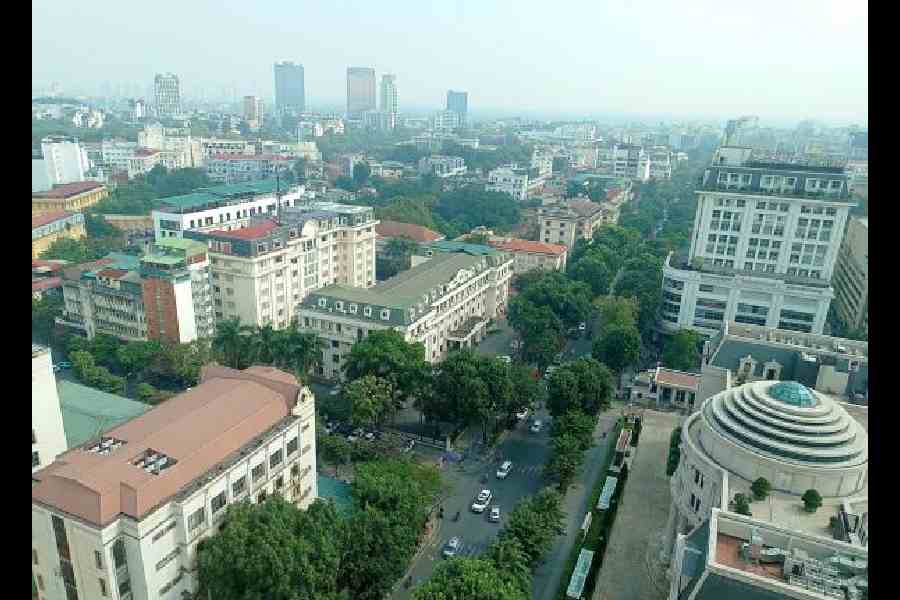A recent visit to Vietnam brought me face-to-face with some fascinating aspects of its history, customs, traditions and lifestyle. I was amazed to learn that a majority of the country’s population is ‘irreligious’ or follows something known as ‘folk’ religion. This is noticeable in most of the local temples, which are in honour of kings or other noble people from the past, rather than Gods.
While driving through the countryside, one also spots several decorative tombs that the Vietnamese build for their ancestors in green rice fields. Their belief is that while people die only in body, their souls remain intact. According to them, these souls will continue to bless and protect their land and family once they are gone. It is for this reason that during the Chinese New Year celebrations or other significant dates in the Lunar calendar, most families have memorial altars in their homes where they honour their ancestors with incense sticks, candles, food and other offerings.

The Temple of Literature is the oldest university in Vietnam and dates back to the 1100s
A Land of Rich History
My comprehensive nine-day visit to Vietnam began in the country’s north, moving down its centre and finally ending in its south. While the north is more traditional and conservative, the south is more prosperous and cosmopolitan. Upon landing in the capital city of Hanoi, I headed first to the Temple of Literature, Vietnam’s first university which was established in the 11th century. On the way, we crossed the city’s vibrant Old Quarter, which was established in the 14th century. Full of bright red lanterns, artificial flowers and other colourful decorations, it consists of 54 streets, each of which is named after the products made here.
The Temple of Literature has some important relics in one of its courtyards, notable of which is a square pool called the ‘Well of Heavenly Brilliance’. Similar to a mirror, it reminds people to look at their own reflections. This is flanked by two rows of stone stelae on pedestals shaped like tortoises. In ancient Chinese characters, the stelae record the names of 1,304 successful candidates in the 82 mandarin examinations held between 1442 and 1779 under the Le and Mac dynasties. There was a rigorous examination system to choose who would become mandarins or imperial officials to assist the king in governing the country. The gruelling examinations, involving numerous stages over several months, were open to all young men of property. The stelae were, however, destroyed by French bombs in 1947, and later rebuilt in 1999-2000.

Karst formations seen on a boat ride at Tam Coc
In folk culture, the turtle is one of four sacred animals, a symbol of longevity. According to legend, the golden turtle lent its claws to An Duong Vuong to create a magic crossbow that defeated the Trieu Da army in the Third century. In the 15th century, the golden turtle lent the magic sword to King Le Loi, which enabled him to win the resistance war against the Ming invaders. After ascending the throne, King Le Loi returned the sword to the turtle on Luc Thuy Lake (Hoan Kiem Lake) or Lake of the Restored Sword. Located in the heart of the city, this was our next stop.
The turtle living here is the Sword Lake turtle, a rare and precious species with only six left in the world. Built in the 13th century, the Ngoc Son temple honours a local warlord called General Tran Hung Dao. Here, visitors can view two specimens of the turtle, which died in 1967 and 2016, respectively, and have been preserved with chemicals. Apart from the turtle, the other three holy animals in Vietnam are the dragon, signifying power; the phoenix, symbolising nobility; and the unicorn, denoting peace. One can see several examples of these at many of the famous ancient temples of the Le and Dinh dynasties in Hoa Lu, located about 100km away from Hanoi.

The guide demonstrating how to get inside one of the Cu Chi tunnels, which was one of the places where the locals hid during the two-decade-long Vietnam War
French influence from the colonial period is strongly resonant in Vietnam today. Ho Chi Minh even has a Notre Dame Church, the only one in the world outside of Paris. A number of French food items, such as baguettes, egg coffee and other aspects of French culture are prevalent here to this day.
Another absorbing visit was the one to the Cu Chi Tunnels in the south of Vietnam, which highlight a turbulent period in the country’s history. Located about an hour and a half away from Ho Chi Minh City, these 250km-long tunnels were built by the locals to hide from American forces during the Vietnam War from 1954 to 1975. This tiny village having shady rubber trees soon transformed into an entire underground city — complete with kitchens, bedrooms, schools, martial facilities, weapon factories, field hospitals and command centres — where the local people lived for several years.
Nature’s Scenery
Vietnam has a treasure trove of some of the most striking natural beauty. While rowing into one of many caves carved through limestone, one passes along the base of some stunning karst formations on a leisurely boat ride at Tam Coc in the Ninh Binh province. Further, a boat ride on Halong Bay, which was officially recognised as one of the natural wonders of the world in 2011, allows viewers to see some more spectacular landscapes filled with islets as well as dark and bright caves.

Hoi An's buildings show various European architectural and design influences
A boat ride on the Mekong river delta is filled with picturesque views of stilt houses, natural canals, water coconut trees and fishing villages. Here, one gets to explore, among other things, a bee farm and a tortoise islet. While honey tea is definitely worth trying here, so is royal jelly, a nutrient that is also great for the skin. At the coconut island, visitors can also see how various goods are manufactured from the fruit, including coconut candy. One also gets to witness some crocodile, snake and fish farms here. At My Tho in the Mekong Delta region, one can also visit the Vinh Trang pagoda, a Buddhist temple with a mix of Chinese and French colonial-style architecture. Built in 1849, the pagoda was restored in 1907. The central idol here is of the leader of modern Buddhism, Bodhidharma, an old man holding a stick with a single shoe.
Big City Attractions
Ho Chi Minh, in the south of Vietnam, is the country’s commercial hub and most developed city. Previously known as Saigon, the city was renamed in 1975 to commemorate the country’s first president. At 666m, the eye-catching yellow bridge in the shape of a dragon, which lies above the Han river that runs through the city, is the longest dragon seen anywhere in the world.

An overhead shot of the city of Hanoi
Da Nang is another bustling coastal city with a touristy vibe having lots of beach-facing hotels and restaurants. One of the primary sightseeing options here includes taking a 5km-long cable car ride that goes up to the lush green Ba Na Hills, perched at a height of 1,500m. A misty place full of clouds and lots of rain most of the year round, it’s a popular hill station among travellers. Getting off the cable car, one is greeted by a little village consisting of delightful castles, gardens and cafes.
The Ba Na gateway, which opened in 2016, is a refinement of the architectural essence of the Hue Imperial Palace and the ancient town of Hoi An. Built in 2017, the Golden Hands Bridge is the most imposing structure here, supported as it is by two giant hands that magically emerge from the cliff. Many of the buildings here, such as the Moon Kingdom, the Lunar Castle, the Helios waterfall, the Eclipse Plaza, the Atlas Statue and French village are influenced by various European architectural styles.
For instance, Le Jardin D’Amour consists of exquisite purple sage flowers that cover the ground on nine levels, representing the nine stages of love. Further, built by the French in 1923, the Debay Wine Cellar is dug 100m into the rocky mountain ground, where there is always an ideal temperature of 16-20 degrees Celsius to store wine. Another interesting attraction in the complex, particularly for young children, is Fantasy Park, a 21,000sq m indoor entertainment area, having exhilarating activities, such as 3D-4D-5D films, bumper cars, rollercoaster rides, drop ‘n twist tower, skiver pilot as well as a wax museum with over 50 wax replicas of celebrities.
Small-town Charm

A shop displaying colourful lanterns at Hoi An
Located about half an hour from Da Nang, Hoi An is a lovely little town known for its crafts and folk art. A former hiding place for the Chinese during the Civil War, its architecture is a mix of French, Italian and Spanish influences. In 1999, Hoi An was recognised for its old heritage housing by Unesco as a world heritage site. A local speciality dish of this ancient town is the Cao Lau noodles, which has existed since the 17th century when the trading port opened. As a result of this, it owes its origin to a combination of several cultures including China, Japan and India.
Hoi An consists of two distinct streets, one of which is Chinese and the other Japanese, both of which are filled with various shops and eateries. Hoi An is a great place to shop for some indigenous handicrafts of the region, including lanterns, clothes stitched in cotton, silk and linen as well as bags, stoles, bamboo hats, fans, hand embroidery and lacquerware art. Those wanting to immerse deeper in the local culture can also sign up for a lantern-making class on these streets.
Walking around Hoi An, one stumbles upon a number of old, quaint buildings. Some of these include the Quan Thang shop house, one of the oldest and most beautiful houses built by a Chinese merchant in the late 17th century, as well as a museum of trade ceramics built in the late 19th century. One also comes across several places of ancestor worship, such as a Chinese Embassy Hall built by a Chinese leader known as Wang Cong, as well as the Tran Family Chapel, which was built as a Vietnamese garden house by a civil mandarin in 1802.
Vietnam’s historic relationship with Japan dates back to the 16th century, when a Vietnamese Princess Ngoc Hoa married a Japanese trader called Araki Soutaro. In 1619, she chose Japan as her homeland and followed her husband to Nagasaki on the Red Seal ship (Shuinsen). These ships were commercial sailboats that were licensed to Southeast Asian ports by the Japanese during the Tokugawa shogunate in the first half of the 17th century. In Hoi An, a model of the Shuinshen is still on display, and is used during Nagasaki’s annual Okunchi festival.
Overall, Vietnam is an engrossing mix of the East and the West. With a total population of about 100 million, the people here are disciplined and hardworking. The perfect combination of old and new, small and big, Vietnam truly has something for everyone.











